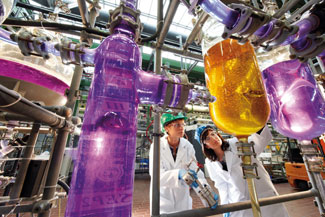At the foundation of the skin is an organic transistor, made from flexible polymers and other carbon based materials. Above that, to allow touches to be detected there is a rubber layer. When pressed it changes thickness which changes the amount of current that flows through the material below. This can then be translated into sensations.
 |
| (Credit: Photos by L.A. Cicero) |
There are also plans to add other kind of sensors to the material.
"With artificial skin, we can basically incorporate any function we desire," said Bao, a professor of chemical engineering. "That is why I call our skin 'super skin.' It is much more than what we think of as normal skin."
Especially detectors for chemicals are planned, and only recently they have managed to demonstrate the concept by detecting a specific type of DNA. This has applications especially in the medical science field, and a glove made from the material could help with the detection of diseases.
The applications for this type of material are endless, from replacing burned skin, to covering robotic prosthetic arms, or to allow robots to sense touches, it could be used for many things.
 |
| Luke Skywalker's artificial hand. Things like this might soon be a reality. |














